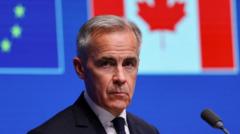As Prime Minister Carney implements plans for internal trade reform, experts warn that the hurdles posed by provincial regulations may impede significant economic growth despite good intentions.
**Canada's Efforts to Strengthen Domestic Trade Amid Tariff Challenges**

**Canada's Efforts to Strengthen Domestic Trade Amid Tariff Challenges**
In light of the tariff conflicts with the U.S., Canada looks within to bolster trade. Prime Minister Carney aims to dismantle barriers, yet faces significant provincial challenges.
Canada's Prime Minister Mark Carney has taken a notable step in response to the ongoing tariff turmoil instigated by President Trump. Since assuming office in the spring of 2025, Carney has emphasized the necessity for Canada to enhance internal trade to counteract the detrimental effects of U.S. tariffs on Canadian exports. The Liberal Party leader has pledged to remove internal trade barriers by July 1, coinciding with Canada Day, marking a significant shift towards fostering a more integrated domestic market.
This ambitious initiative culminated in the passage of a bill through Parliament aimed at eliminating federal trade restrictions that currently inhibit the movement of goods and labor across the country. Carney expressed optimism over this reform, asserting that cultivating a unified Canadian economy would provide resilience against external threats, stating, “We will give ourselves more than any foreign nation can ever take away by building one Canadian economy — the strongest economy in the G7.”
However, the path to a stronger domestic market is fraught with challenges, as Canada is composed of 10 provinces and three territories, each with its own regulatory framework that complicates internal trade. Economists warn that these localized barriers present substantial obstacles that could overshadow the benefits of federal reforms.
Though the consensus is that enhancing internal trade policy would be positive for Canada’s economy, analysts are cautious. The country’s expansive geography, relatively small consumer base of approximately 40 million, and the pervasive globalization of manufacturing suggest that it is unlikely that domestic trade can fully compensate for the losses incurred from diminished access to the lucrative U.S. market in the foreseeable future.
This ambitious initiative culminated in the passage of a bill through Parliament aimed at eliminating federal trade restrictions that currently inhibit the movement of goods and labor across the country. Carney expressed optimism over this reform, asserting that cultivating a unified Canadian economy would provide resilience against external threats, stating, “We will give ourselves more than any foreign nation can ever take away by building one Canadian economy — the strongest economy in the G7.”
However, the path to a stronger domestic market is fraught with challenges, as Canada is composed of 10 provinces and three territories, each with its own regulatory framework that complicates internal trade. Economists warn that these localized barriers present substantial obstacles that could overshadow the benefits of federal reforms.
Though the consensus is that enhancing internal trade policy would be positive for Canada’s economy, analysts are cautious. The country’s expansive geography, relatively small consumer base of approximately 40 million, and the pervasive globalization of manufacturing suggest that it is unlikely that domestic trade can fully compensate for the losses incurred from diminished access to the lucrative U.S. market in the foreseeable future.





















